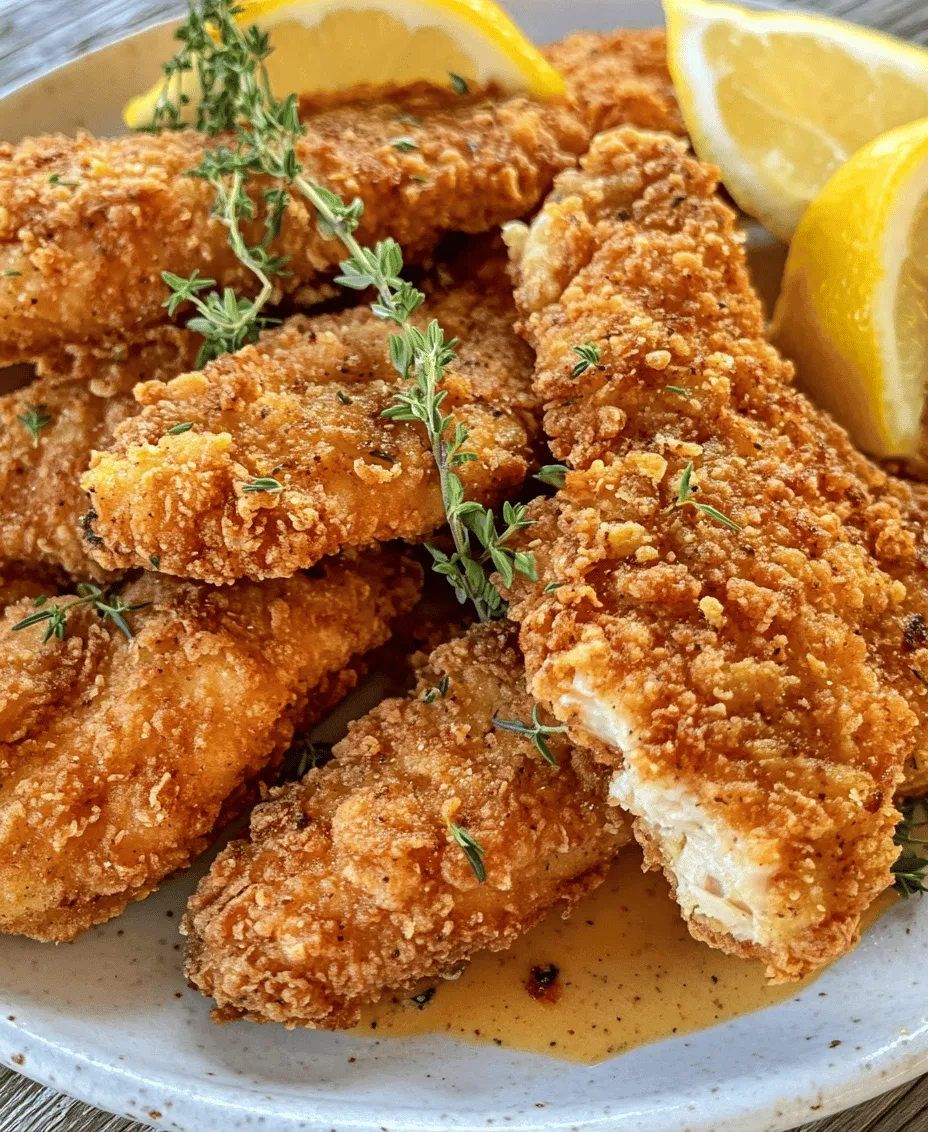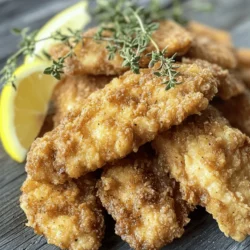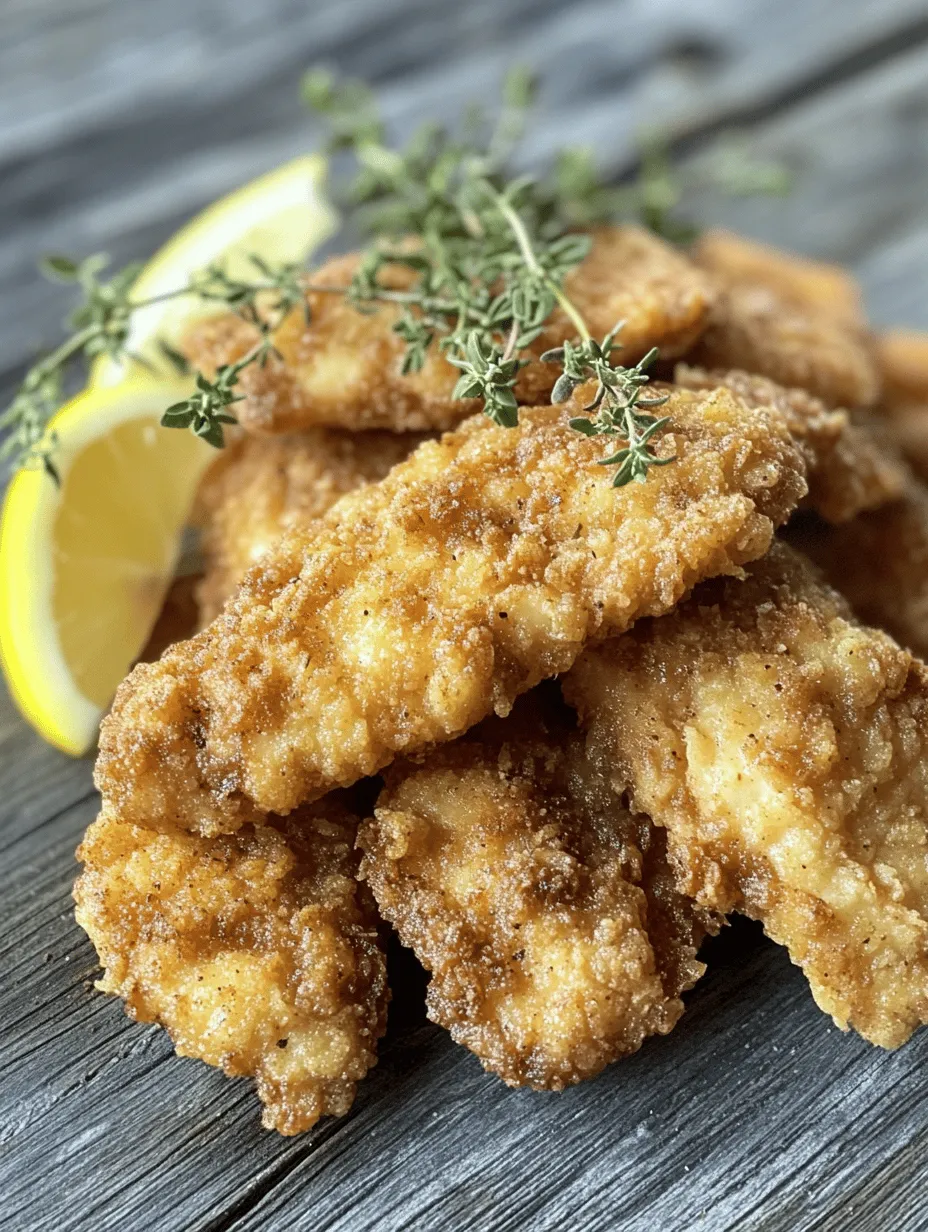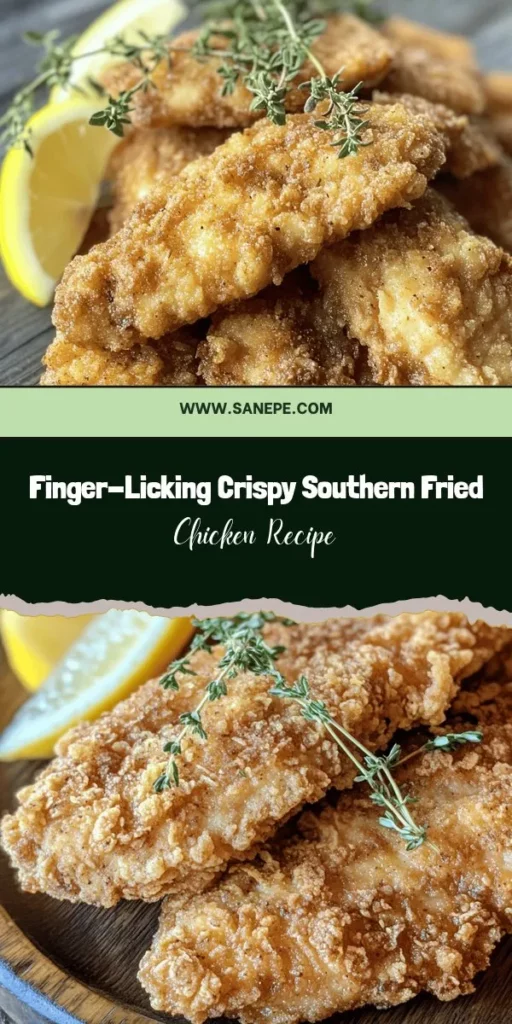Introduction: Exploring the Joy of Southern Fried Chicken
Southern cuisine is more than just a collection of recipes; it embodies a rich tapestry woven from history, culture, and tradition. Known for its bold flavors and hearty dishes, Southern cooking has deep roots in the American culinary landscape, reflecting the diverse influences of African, Native American, and European traditions. Among the many iconic dishes that represent this vibrant cuisine, fried chicken stands out as a quintessential comfort food, cherished for its crispy exterior, juicy interior, and the warmth it brings to family gatherings and celebrations.
Fried chicken is not just a meal; it is an experience. It’s the centerpiece of Sunday dinners, backyard barbecues, and potlucks, evoking fond memories and the shared joy of loved ones coming together. The mere thought of crispy, golden-brown fried chicken can trigger nostalgia, transporting one back to cherished moments spent around the dinner table. The recipe we are about to explore, “Crispy Southern Delight – Finger-Licking Fried Chicken,” celebrates this beloved dish, promising to deliver a flavor experience that is both authentic and unforgettable.
At the heart of perfect fried chicken lies the art of marination and seasoning. The well-timed infusion of flavors and moisture is crucial to achieving that tender and juicy bite that makes fried chicken a standout dish. In this article, we will delve into the essential steps needed to recreate this Southern classic, beginning with the magic of buttermilk marinade.
The Magic of Buttermilk Marinade
Marination is a transformative process that elevates the flavors of chicken while ensuring tenderness and moisture retention. When it comes to fried chicken, buttermilk is a champion ingredient. The lactic acid in buttermilk works wonders, breaking down protein strands in the chicken, leading to irresistibly juicy and tender meat. Additionally, buttermilk serves as a flavor carrier, allowing spices and herbs to penetrate deeply, resulting in a richly flavored dish.
To harness the full potential of buttermilk, it’s important to allow the chicken ample time to soak in this creamy marinade. A minimum marination period of 4 hours is recommended, but for optimal flavor development, consider allowing the chicken to marinate overnight in the refrigerator. This extended time not only enhances the flavor but also contributes to the overall texture of the chicken, ensuring that each bite is moist and succulent.
When selecting chicken pieces for your fried chicken recipe, consider a mix of legs, thighs, and breasts. Each cut offers a unique texture and flavor profile, ensuring a diverse and satisfying eating experience. Dark meat pieces, such as thighs and drumsticks, tend to be more flavorful and remain juicy even after frying, while the breast meat provides a leaner option for those who prefer it. A combination of these cuts will cater to varied preferences and make your fried chicken spread even more appealing.
Crafting the Perfect Seasoned Coating
The seasoned flour mixture is a critical element in achieving that signature crispy texture that fried chicken is renowned for. A well-crafted coating not only provides the crunch that fried chicken lovers crave but also seals in the moisture of the chicken, creating a delightful contrast with the tender meat inside.
To create the perfect seasoned flour mixture, you will need to gather a few key spices and ingredients. Here’s a detailed breakdown of the spices that work together harmoniously to create a flavor-packed coating:
– Paprika: This spice not only adds a beautiful reddish hue to the chicken but also contributes a subtle smokiness that enhances the overall flavor profile. Opt for smoked paprika if you desire an even deeper smoky flavor.
– Garlic and Onion Powder: These two essentials are the backbone of many savory dishes, and they bring a depth of flavor to your fried chicken. Their natural sweetness complements the savory notes of the chicken, making every bite a flavor explosion.
– Cayenne Pepper: If you enjoy a little heat, cayenne pepper is your friend. Adjust the amount according to your heat tolerance; a pinch adds just the right kick without overpowering the rest of the flavors.
– Black Pepper, Salt, Thyme, and Oregano: These spices round out the seasoning mix, balancing flavors and adding aromatic notes. Salt enhances the overall flavor, while thyme and oregano lend an earthy quality that complements the chicken beautifully.
If you have dietary restrictions or preferences, don’t hesitate to tweak the coating. Gluten-free individuals can substitute traditional all-purpose flour with gluten-free alternatives like almond flour or a gluten-free all-purpose blend. Additionally, feel free to experiment with different spices, such as cayenne for heat or Italian seasoning for a herby twist, to create a signature blend that resonates with your palate.
The Art of Frying Chicken
With your chicken marinated and your seasoned flour mixture prepared, the next step on this culinary journey is frying the chicken to golden perfection. The frying process is an art that requires attention to detail, as the right temperature and technique can make all the difference in achieving that coveted crispy crust.
Before you start frying, ensure that you have the right oil for the job. Peanut oil is a popular choice among many Southern cooks due to its high smoke point and neutral flavor, making it perfect for frying. However, you can also use vegetable oil or canola oil if preferred. Whichever oil you choose, make sure to heat it to the right temperature—usually around 350°F (175°C) is ideal for frying chicken. An instant-read thermometer can be an invaluable tool in this process, ensuring consistency and preventing any mishaps.
Once your oil is hot, carefully dredge each piece of marinated chicken in the seasoned flour mixture, ensuring an even coating. Gently shake off any excess flour to avoid clumping, then place the chicken in the hot oil. Avoid overcrowding the pan, as this can lower the oil temperature and result in soggy chicken. Frying in batches is recommended to maintain optimal cooking conditions.
Fry each piece for about 12 to 15 minutes, turning occasionally to achieve even browning. The chicken is done when it reaches an internal temperature of 165°F (74°C) on an instant-read thermometer, ensuring that it is cooked through while still juicy. Once cooked, transfer the chicken to a wire rack set over a baking sheet to drain excess oil and maintain crispiness.
As you embark on this culinary adventure, remember that the heart of Southern fried chicken lies in the love and care put into each step. From marinating and seasoning to frying, each action contributes to the creation of a dish that embodies comfort, nostalgia, and the essence of Southern hospitality.
In the next part of our journey, we will delve deeper into serving suggestions, side dishes that pair beautifully with fried chicken, and tips for storing leftovers, ensuring that your experience with “Crispy Southern Delight – Finger-Licking Fried Chicken” is nothing short of extraordinary.

Mastering the Art of Frying Chicken
Frying chicken to perfection requires not only the right ingredients but also an understanding of the frying process itself. One of the most critical aspects of frying chicken is the oil temperature. The right temperature ensures that the chicken cooks evenly while developing that irresistible crispy crust.
Importance of Oil Temperature in Frying Chicken
When it comes to frying chicken, the temperature of your oil can make or break your dish. If the oil is too cold, the chicken will absorb excess oil and become greasy rather than crispy. Conversely, if the oil is too hot, the exterior may burn before the inside is fully cooked. The ideal frying temperature for chicken is between 350°F to 375°F (175°C to 190°C). This temperature range allows the chicken to cook through without losing moisture, resulting in tender meat encased in a crunchy crust.
Recommended Oils: Peanut Oil vs. Vegetable Oil
Choosing the right oil is crucial for achieving that perfect fry. Two popular choices are peanut oil and vegetable oil.
– Peanut Oil: This oil is favored by many chefs due to its high smoke point, around 450°F (232°C). This high smoke point allows for frying at higher temperatures, which can yield a crispier chicken. Additionally, peanut oil has a subtle nutty flavor that can enhance your dish without overpowering it.
– Vegetable Oil: Vegetable oil, often a blend of different oils, typically has a smoke point ranging from 400°F to 450°F (204°C to 232°C). It’s a versatile option, perfect for frying chicken while being more affordable than peanut oil. However, it may not impart as much flavor as peanut oil.
Step-by-Step Guide to Heating the Oil Correctly
1. Choose Your Pot: Select a deep, heavy-bottomed pot or a Dutch oven. This will help maintain a consistent temperature throughout the frying process.
2. Add Oil: Pour in enough oil to submerge the chicken pieces halfway. This usually requires about 2-3 inches of oil, depending on the size of your pot.
3. Heat the Oil: Place the pot over medium heat and use a thermometer to monitor the temperature. If you don’t have a thermometer, drop a small piece of bread into the oil – it should sizzle and turn golden brown in about 60 seconds when the oil is ready.
4. Adjust the Heat: Once the oil reaches the desired temperature, adjust the heat to maintain it. Too high, and the oil will burn; too low, and the chicken won’t fry properly.
Techniques for Frying Without Overcrowding the Pan
Frying chicken in batches is essential for achieving that crispy texture. Overcrowding the pan can lower the oil temperature, leading to soggy chicken.
1. Work in Batches: Fry only a few pieces of chicken at a time. This allows the oil temperature to remain consistent, ensuring even cooking.
2. Leave Space: Arrange the chicken pieces in the pot with space between them. This promotes even frying and prevents pieces from sticking together.
3. Monitor the Temperature: Keep a close eye on the oil temperature between batches. If it drops too low, give it time to heat back up before adding the next batch.
How to Achieve That Perfect Golden-Brown Crust
To achieve a golden-brown crust, follow these simple guidelines:
1. Fry at the Right Temperature: As mentioned earlier, maintain your oil temperature between 350°F to 375°F.
2. Don’t Rush: Allow the chicken to fry undisturbed for a few minutes before flipping. This gives the crust time to form.
3. Use a Slotted Spoon: When flipping or removing the chicken, use a slotted spoon or tongs to avoid breaking the crust.
4. Check for Color: Look for a deep golden-brown color on the crust before removing the chicken from the oil.
Ensuring Safety and Quality in Frying
Food safety is paramount when frying chicken. Undercooked chicken can pose health risks, so it’s essential to ensure it reaches the recommended internal temperature.
Discussing Food Safety: Cooking Chicken to the Recommended Internal Temperature
The USDA recommends cooking chicken to an internal temperature of 165°F (74°C). This temperature ensures that harmful bacteria are killed, making your chicken safe to eat.
– Using a Thermometer for Accuracy: The best way to check doneness is with an instant-read thermometer. Insert it into the thickest part of the chicken, avoiding bones for an accurate reading.
Tips for Draining Excess Oil and Maintaining Crispiness After Frying
Once the chicken is cooked, it’s essential to drain excess oil to maintain its crispiness.
1. Use a Wire Rack: Place fried chicken on a wire rack over a baking sheet. This allows air to circulate around the chicken, preventing it from steaming and becoming soggy.
2. Paper Towels: If a wire rack isn’t available, placing the chicken on paper towels can also help absorb excess oil. Be sure to change the paper towels as needed.
3. Serve Immediately: For the best texture, serve the chicken right after frying. If you need to keep it warm, place it in a low-temperature oven (about 200°F or 93°C) on a wire rack.
Serving Suggestions and Pairings
Fried chicken is a versatile dish that pairs beautifully with a variety of sides and garnishes. Presentation matters, so consider these serving ideas:
Presentation Ideas
– Garnish with Fresh Herbs: Add a touch of freshness by garnishing your fried chicken with sprigs of fresh thyme or parsley. Lemon wedges can add a pop of color and a hint of acidity that complements the richness of the chicken.
Suggested Side Dishes That Complement Fried Chicken
1. Classic Coleslaw: The creamy, tangy crunch of coleslaw balances the richness of fried chicken and adds a refreshing element to your plate.
2. Cornbread or Biscuits: Soft, warm cornbread or flaky biscuits are perfect for soaking up any leftover juices and enhance the Southern feel of the meal.
3. Creamy Mashed Potatoes: Smooth, buttery mashed potatoes topped with gravy make for a comforting side that pairs wonderfully with fried chicken.
Ideas for Sauces and Dips
– Hot Sauce: For those who love a little heat, offering a side of hot sauce can elevate the flavor of your fried chicken.
– Honey: A drizzle of honey adds a sweet contrast to the savory chicken, making it a delightful pairing.
– Ranch Dressing: Creamy ranch dressing can be a fantastic dip for those who enjoy a cool, tangy accompaniment.
Conclusion: Savoring the Flavor of Southern Fried Chicken
Fried chicken is more than just a meal; it’s a culinary tradition that brings people together. By mastering the steps and techniques outlined in this guide, you can create the perfect crispy Southern fried chicken to share with family and friends.
Recap the key points: from ensuring the right oil temperature and frying in batches to achieving that golden-brown crust and serving with complementary sides, each step contributes to the final dish.
Reflect on the cultural significance of sharing meals with loved ones, the memories created around the dinner table, and the joy of indulging in homemade comfort food.
So why not embrace the process? Gather your ingredients, follow the recipe, and enjoy the rewarding experience of cooking and sharing this timeless dish. Your kitchen will be filled with the irresistible aroma of fried chicken, and your loved ones will savor every bite. Enjoy your culinary adventure!


